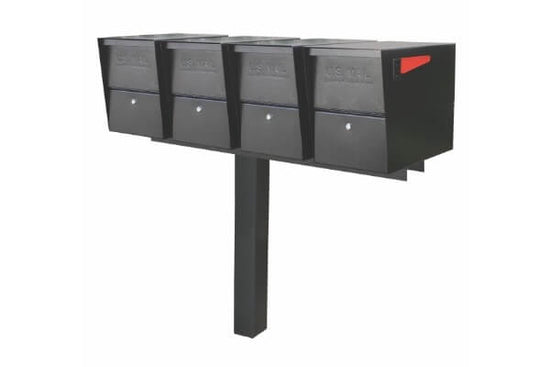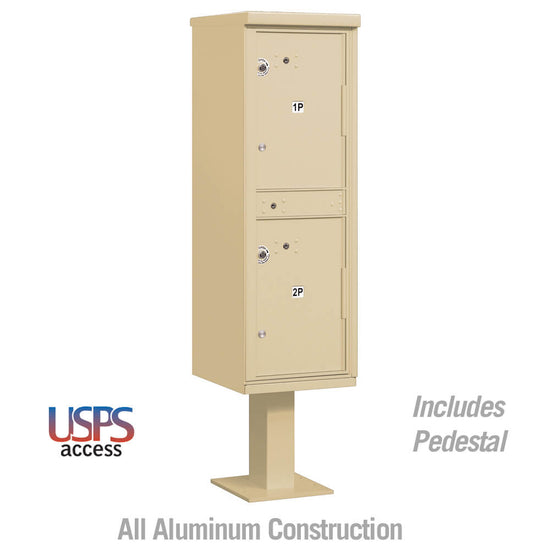Snowplows are practical solutions for keeping roads safe during the winter months. They tackle snow and ice to keep our roads safe and our lives on track.
But here’s the twist: these machines can sometimes play mailbox wrecking ball as they power through the snow. The snow they throw can take a toll on your mailbox, leaving you with a recurring DIY project you never signed up for.
In this quick post, we take a look at how to protect your mailbox from snowplow trucks. You can keep your mailbox intact and your mail deliveries uninterrupted even in the harshest winter conditions by simply following the essential tips we’ll share here.
Let’s get right to it.
Choose a Sturdy Mailbox Post
The first step to safeguarding your mailbox against the relentless force of snowplows is making sure it sits on a sturdy foundation ― the mailbox post.
When installing a curbside mailbox, opt for a robust and durable mailbox post that can withstand the impact of snow, ice, and whatever else winter throws its way.
Keep the following factors in mind:
- Material: A sturdy mailbox post is usually made of steel or heavy-duty plastic. These materials can handle the pressure of snowplow encounters better than wooden posts.
- Reinforcement: Some mailbox posts have extra reinforcement features, like a support arm or crossbar. These additions can help your mailbox stay upright even when faced with a wall of snow from a passing plow.
- Swing-away design: For ultimate protection, consider a swing-away mailbox post. These nifty posts can pivot when snow strikes, reducing the chances of severe damage.
Remember, the post is the first line of defense against snowplow impacts, so invest in one that can take a hit and keep your mailbox secure.
Follow Proper Mailbox Placement
The placement of your mailbox is crucial in protecting it from snowplow-related damage. Besides making it easier for your mail carrier to do their job, adhering to proper mailbox placement guidelines reduces the risk of damages that may occur if your mailbox is too close to the road.
You want to check your local regulations and recommendations for mailbox placement. The USPS requires US residents to position their mailboxes 6 to 8 inches from the edge of the road.
This helps prevent snowplows from coming into direct contact with the mailbox. That said, for additional peace of mind and to reduce the risk of accidental snowplow damage, it is usually a good idea to keep it at least 10 to 12 inches back from the road.
Use Reflective Material for Visibility

Visibility is key when it comes to keeping your mailbox safe from snowplows. You want to boost your mailbox’s visibility, especially during the dark and snowy winter months, to reduce the chances of it getting hit.
Reflective materials are a small investment that can make a big difference in preserving your mailbox during the winter season.
Here’s how you can do it:
- Reflective tape or paint: Apply reflective tape to your mailbox to make it highly visible, even in low-light conditions. Snowplow operators will spot it more easily, reducing the risk of accidental damage. Don’t have reflective tape? No worries; you can paint your mailbox with bright colors to enhance its visibility.
- Reflective numbers: Use reflective numbers to display your house number or address on your mailbox. This not only helps mail carriers locate your mailbox but also makes your mailbox stand out in the snow.
- Reflective post markers: Consider adding reflective markers or tall poles near your mailbox. These can serve as additional visual cues for snowplow operators, indicating the mailbox’s location without them having to come too close.
Consider a Cluster Box
If you live in an area with severe snow problems, it might be time to think outside the box and consider switching to a cluster mailbox system. These systems involve grouping several mailboxes together in a central location.
With a cluster mailbox, your individual mailbox is less exposed to the dangers of snowplow encounters; it’s less likely to be a direct target since it is part of a group.
Plus, snowplow operators can clear snow more efficiently without worrying about hitting individual mailboxes. This can help keep your mail deliveries on track even during the worst winter days.
While cluster mailbox systems can benefit the entire community by reducing individual mailbox repairs and replacements, make sure to check your local regulations and discuss the idea with your neighbors before making the switch.
Maintain Clear Driveways
While it might seem unrelated, maintaining a clear driveway can be a significant factor in protecting your mailbox from snowplows.
Keep your driveway free of snow as much as possible, especially the area around your mailbox. This helps snowplow operators do their jobs more easily without having to come too close to your mailbox.
In addition to clearing your driveway, it’s usually a good practice to use snow stakes or reflectors to mark the boundaries of your driveway. These can help snowplow operators identify the edges and avoid your mailbox.
Remember to allow enough clearance between your mailbox and the driveway edge. This prevents snowplows from pushing excessive amounts of snow against your mailbox during clearing.
When you clear your driveway and the snow around your post-mounted mailbox, you are not only assisting snowplow operators but also reducing the risk of damage to your mailbox.
Consider Temporary Removal of Your Mailbox
Sometimes, temporal retreat is the best way to protect mailbox from snowplow trucks. Remove your mailbox, especially in heavy snowfall or during major snow-clearing operations. This can help prevent damage and allow snowplow operators to clear the road more effectively.
Remember to follow postal guidelines regarding mailbox removal procedures. It is also necessary to discuss with your local postal service to ensure your mail delivery continues without interruption during the temporary removal.








